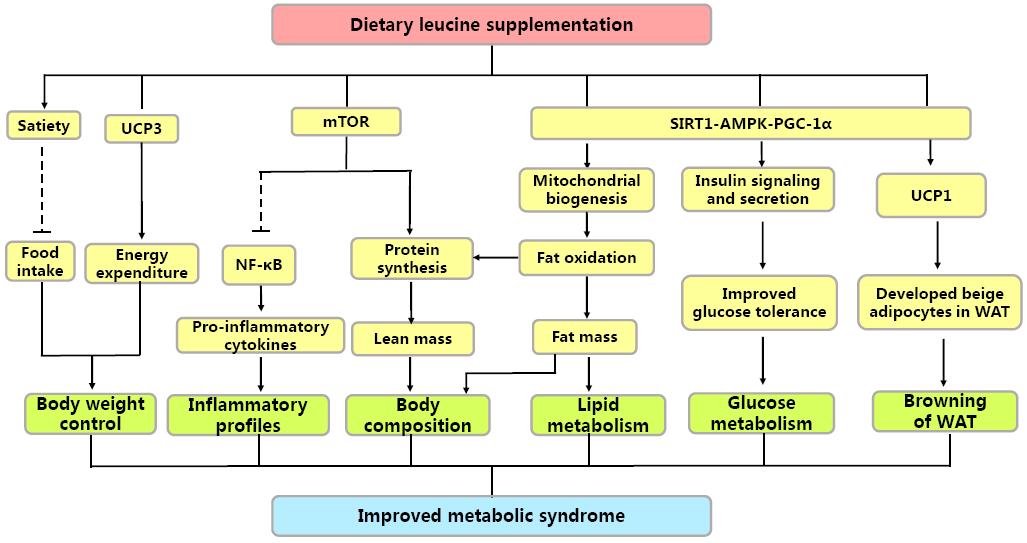Targeting Leucine in the Treatment of Obesity
The prevalence of obesity and obesity-related metabolic disorders is rapidly increasing all over the world, increasing the risk to develop insulin resistance and diabetes. Consequently, approaches for reducing the current obesity epidemic are becoming a primary focus of human health care.
Recently, a team of researchers from China Agricultural University, the Institute of Subtropical Agriculture, Chinese Academy of Sciences (ISA) highlight leucine, an essential and branched-amino acid, as a compound with potential therapeutic value towards obesity and its associated metabolic disorders. Leucine is an important mediator of appetite and satiety, energy expenditure, lipid and glucose metabolism, insulin sensitivity, chronic inflammation, browning of white adipose tissue, and other metabolic processes. Although not widely appreciated, the beneficial effects of dietary leucine supplementation include increased loss of body weight, reduced WAT inflammation, improved lipid and glucose metabolism, enhanced mitochondrial function, and preserved lean body mass (Figure 1). However, in contrast to the salutary effects of leucine described above, there is evidence showing that elevated tissue and blood levels of leucine both in obese humans and animals prognosticate future risk of developing diabetes. Therefore, for the use of leucine as a potential therapeutic, the major outstanding question is whether elevated leucine levels cause inacceptable adverse effects, such as augmenting the future risk of developing insulin resistance and diabetes. Thus, further studies are needed to address the safe upper range of leucine that can be used in the treatment of obesity.
The research was the jointly supported by the National Natural Science Foundation of China (31110103909, 31330075), the National Basic Research Program of China (2013CB127305, 2012CB124704), the National Natural Science Foundation of China (31472107, 31572416, and 31372319), the Youth Innovation Promotion Association CAS (2015), the Nature Science Foundation of Hunan Province (2015JJ2146), the Special Fund for Agro-scientific Research in the Public Interest (201403047), the Innovation Research Team Development Program of MOE of China (IRT0945), The Chinese Academy of Science STS Project (KFJ-EW-STS-063), Key Projects in the National Science & Technology Pillar Program (2013BAD21B04), the Hunan Key Project (2015NK1002), the Changsha Lvye Biotechnology Limited Company Academician Expert Workstation, the Guangdong Wangda Group Academician Workstation for Clean Feed Technology Research and Development in Swine, the Guangdong Hinapharm Group Academician Workstation for Biological Feed and Feed Additives and Animal Intestinal Health, the Hunan New Wellful Co. Ltd. Academician Workstation, the Hubei Provincial Key Project for Scientific and Technical Innovation (2014ABA022), the Chinese Academy of Sciences "Hundred Talents Program", the Hubei Hundred Talent program, and the Natural Science Foundation of Hubei Province (2013CFA097, 2013CFB325, 2012FFB04805 and 2011CDA131).
The study entitled "Leucine in Obesity: the Therapeutic Potential" has been published in Trends in Pharmacological Sciences, details could be found at http://dx.doi.org/10.1016/j.tips.2016.05.004.

Figure 1. Simplified scheme of possible mechanisms of the beneficial effects of dietary leucine supplementation on the metabolic syndrome. SIRT1, Sirtuin 1; AMPK, AMP-activated protein kinase; PGC-1a, peroxisome proliferator-activated receptor gamma coactivator-1a; WAT, white adipose tissue.
Contact: DUAN Yehui
E-mail: todyfly1@163.com
Institute of Subtropical Agriculture, Chinese Academy of Sciences
Download attachments: